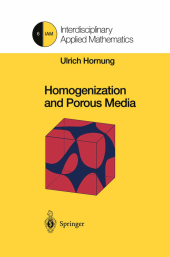 Neuerscheinungen 2012Stand: 2020-01-07 |
Schnellsuche
ISBN/Stichwort/Autor
|
Herderstraße 10
10625 Berlin
Tel.: 030 315 714 16
Fax 030 315 714 14
info@buchspektrum.de |

Ulrich Hornung
Homogenization and Porous Media
Herausgegeben von Hornung, Ulrich
Softcover reprint of the original 1st ed. 1997. 2012. xvi, 279 S. 13 SW-Abb. 235 mm
Verlag/Jahr: SPRINGER, BERLIN 2012
ISBN: 1-461-27339-0 (1461273390)
Neue ISBN: 978-1-461-27339-4 (9781461273394)
Preis und Lieferzeit: Bitte klicken
This book offers a systematic, rigorous treatment of upscaling procedures related to physical modeling for porous media on micro-, meso- and macro-scales, including detailed studies of micro-structure systems and computational results for dual-porosity models.
For several decades developments in porous media have taken place in almost independent areas. In civilengineering, many papers were publisheddealing with the foundations offlow and transport through porous media. The method used in most cases is called averaging, and the notion ofa representative elementary vol ume(REV)playsanimportantrole. Inchemicalengineering,papersonconceptual models were written on the theory ofmixtures. Intheoretical physics and stochas tic analysis, percolation theory has emerged, providing probabilistic models for systems where theconnectedness propertiesofsomecomponentdominatethebe havior. In mathematics, atheoryhasbeendevelopedcalled homogenizationwhich deals with partial differential equations having rapidly oscillating coefficients. Early work in these and related areas was - among others - done by the fol lowing scientists: Maxwell [Max81] and Rayleigh [Ray92] studied the effective conductivity of media with small concentrations of randomly and periodically, respectively, arranged inclusions. Einstein [Ein06] investigated the effective vis cosityofsuspensions with hard spherical particles in compressible viscous fluids. Marchenko and Khrouslov [MK64] looked at the asymptotic nature of homog enization; they introduced a general approach of averaging based on asymptotic tools which can handle a variety ofdifferent physical problems. Unfortunately, up to now, little efforthas been made to bridge the gap between these different fields of research. Consequently, many results were and are dis covered independently, and scientists are almost unable to understand each other because the respective languages have been developing in different directions.


